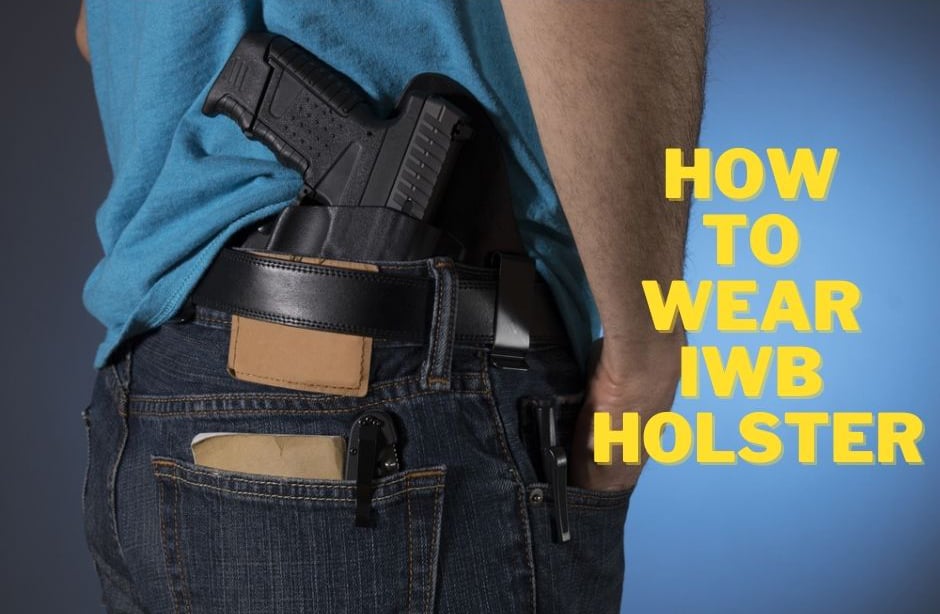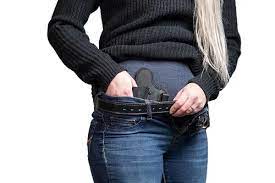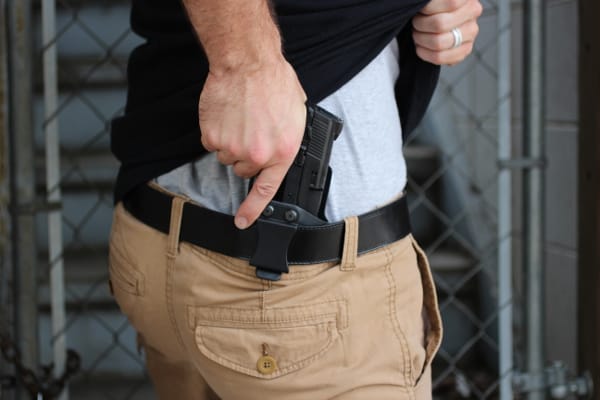If you’re a new gun user, you might be wondering how to carry your firearm around safely without letting the world know that you have a gun. Most gun owners choose an inside-the-waistband holster also called an IWB holster. This type of holster is a naturally concealed carry and it provides the finest concealment as well as easy access to your weapon in an emergency. This means that it is a comfortable holster if you use it the right way.

Once you’ve discovered the advantages of an inside-the-waistband holster, you’ll never want to carry your pistol any other way. It is a great idea to try out a few different holster carry positions, but as a shooter, you must eventually pick one that works best for him. Let’s look at how to wear IWB holster.
Contents
- Definition of IWB Holster
- Importance of Properly Wearing IWB Holster
- Understanding IWB Holster Positioning
- How to Wear IWB Holster Properly
- Introduction
- I. Step-by-Step Guide on Wearing IWB Holster
- Tips for Comfortable and Secure IWB Holster Wear
- Common Mistakes to Avoid When Wearing IWB Holster
- Frequently Asked Questions (FAQs)
Definition of IWB Holster
An Inside-the-Waistband (IWB) holster is a popular method of carrying a firearm concealed. It is designed to be worn inside the waistband of the pants, providing a secure and discreet way to carry a firearm. The holster is typically made of a durable material, such as leather or Kydex, and is specifically designed to hold the firearm in place while allowing for a quick and smooth draw.
Importance of Properly Wearing IWB Holster
Properly wearing an IWB holster is crucial for several reasons. Firstly, it ensures the safety of the individual carrying the firearm. By securely positioning the holster inside the waistband, it minimizes the risk of accidental discharge or unauthorized access to the weapon. Additionally, it provides comfort and convenience to the wearer, allowing for easy access and comfortable carry throughout the day.
Understanding IWB Holster Positioning
A. Explaining the Inside-the-Waistband (IWB) Carry Method
The Inside-the-Waistband (IWB) carry method involves placing the holster inside the waistband, between the pants and the body. The holster is typically clipped or secured to the waistband, ensuring it stays in place during movement. This method offers excellent concealment, as the firearm is tucked close to the body, reducing the chances of it being noticed by others.
B. Benefits of IWB Holster Positioning
The positioning of an IWB holster offers several benefits. Firstly, it provides better concealment compared to other carry methods, such as outside-the-waistband holsters. The firearm is hidden beneath clothing, making it less likely to draw attention or cause discomfort. Additionally, the close proximity to the body enhances weapon retention, making it more difficult for an attacker to disarm the wearer.
C. Factors to Consider for Proper Positioning
When it comes to properly positioning an IWB holster, there are a few factors to consider. Firstly, the holster should be positioned at the strong-side hip area, allowing for a natural and quick draw with the dominant hand. The ride height and cant of the holster should also be adjusted to personal preference and comfort. Experimentation with different positions and adjustments may be necessary to find the optimal positioning for each individual.
How to Wear IWB Holster Properly
Introduction
Carrying a concealed firearm is a responsibility that requires proper knowledge and technique. One popular method of concealed carry is using an Inside-the-Waistband (IWB) holster. The IWB holster offers a comfortable and discreet option for carrying a firearm. However, wearing an IWB holster properly is crucial to ensure both comfort and safety. In this article, we will provide you with a step-by-step guide on how to wear an IWB holster correctly and offer tips for comfortable and secure wear.

I. Step-by-Step Guide on Wearing IWB Holster
To wear an IWB holster effectively, follow these steps:
1. Choosing the Right Holster Size and Type
The first step in wearing an IWB holster properly is selecting the right size and type of holster. The holster should be specifically designed for the firearm you intend to carry. Consider factors such as the gun’s dimensions, weight, and trigger guard coverage when choosing a holster. Opt for a holster that provides a secure fit and proper retention.
2. Selecting the Appropriate Clothing
When wearing an IWB holster, clothing selection plays a crucial role in concealment and comfort. Choose garments that are slightly larger to accommodate the additional bulk of the holster and firearm. Avoid tight-fitting clothing that may print or reveal the outline of the firearm. Concealed carry-specific clothing options, such as shirts with built-in holsters, can further enhance concealment.
3. Identifying the Ideal IWB Holster Placement
The placement of the IWB holster on your body is essential for both comfort and accessibility. Experiment with different positions until you find the one that works best for you. Common locations include the strong-side hip, appendix, or small of the back. Ensure the holster is positioned securely and does not sag or shift during movement.
4. Adjusting the Retention and Cant Angle
Once you have determined the optimal position, adjust the retention and cant angle of the holster. Retention refers to the level of friction or tension exerted on the firearm to keep it in place. It should be firm enough to prevent accidental dislodging but still allow for a smooth draw. The cant angle determines the degree of tilt or angle at which the holster is positioned for easy access and a natural draw motion.
Tips for Comfortable and Secure IWB Holster Wear

To ensure a comfortable and secure experience while wearing an IWB holster, consider the following tips:
1. Importance of Proper Belt Selection
A sturdy and supportive belt is crucial when wearing an IWB holster. Opt for a belt specifically designed for concealed carry, as it offers enhanced rigidity and stability. The belt should comfortably support the weight of the firearm and holster, preventing sagging or shifting during movement. Avoid using flimsy or elastic belts that may compromise security.
2. Ensuring Adequate Retention and Trigger Protection
Maintaining proper retention and trigger protection is paramount when carrying a concealed firearm. Regularly inspect your holster for any signs of wear or damage that may compromise retention. Additionally, ensure the trigger is fully covered and protected to prevent accidental discharges. Holsters with adjustable retention and trigger guard covers provide added safety.
3. Adjusting Clothing for Concealment and Accessibility
To achieve effective concealment and easy access to your firearm, make necessary adjustments to your clothing. Tuck in your shirt or blouse behind the holster to prevent it from snagging during the draw. Ensure your clothing adequately covers the firearm to avoid printing or revealing its presence. Practice drawing from various positions to ensure smooth and efficient access.
Common Mistakes to Avoid When Wearing IWB Holster
Wearing an inside-the-waistband (IWB) holster can be a convenient and effective way to carry a concealed firearm. However, there are some common mistakes that people make when using an IWB holster. In this article, we will discuss these mistakes and provide guidance on how to avoid them, ensuring a safe and comfortable carrying experience.
A. Tight Clothing Interference
One of the most common mistakes when wearing an IWB holster is choosing clothing that is too tight. Tight clothing can interfere with the draw stroke and make it difficult to access the firearm quickly when needed. It can also cause discomfort and restrict movement. To avoid this mistake, it is important to wear clothing that allows for easy access to the holster and a smooth draw.
B. Inadequate Retention and Trigger Coverage
Another mistake to avoid is using an IWB holster that does not provide sufficient retention and trigger coverage. The holster should securely hold the firearm in place and cover the trigger guard completely to prevent accidental discharges. Choosing a high-quality holster that is specifically designed for your firearm model and offers adjustable retention is essential. Regularly check the holster’s retention and ensure that it is properly adjusted to provide a secure fit.
C. Poor Holster Placement and Cant Angle
Improper holster placement and cant angle can greatly affect comfort and concealability. Placing the holster too far forward or backward can lead to discomfort and printing, where the outline of the firearm becomes visible through clothing. Additionally, an incorrect cant angle can make the draw stroke awkward and hinder the ability to acquire a proper firing grip. Experiment with different positions and angles to find the one that works best for you. It is recommended to position the holster at the strong-side hip for most people.
D. Neglecting to Regularly Inspect and Maintain the Holster
Regular inspection and maintenance of your IWB holster are crucial for its proper functioning and longevity. Over time, dirt, dust, and debris can accumulate in the holster, affecting retention and draw smoothness. Inspect the holster regularly for any signs of wear or damage, such as loose screws or frayed edges. Clean the holster according to the manufacturer’s instructions and ensure it is dry before reinserting the firearm. Lubricate any moving parts if necessary.
Frequently Asked Questions (FAQs)
Now let’s address some frequently asked questions related to wearing an IWB holster.
1. How does an IWB Holster differ from other types of holsters?
An IWB holster is designed to be worn inside the waistband, usually between the pants and underwear. It offers better concealment compared to outside-the-waistband (OWB) holsters.
2. Can IWB Holsters be used for different firearms?
Yes, iwb holsters are available for a wide range of firearm models. Ensure you choose a holster that is specifically designed for your firearm to ensure a secure and proper fit.
3. Is there a specific body type suitable for IWB Holster wear?
IWB holsters can be worn by individuals of different body types. However, individuals with a larger body build may find it more challenging to conceal larger firearms with an IWB holster.
4. What are the advantages of wearing an IWB Holster?
Some advantages of wearing an IWB holster include better concealment, easy access to the firearm, and a more comfortable carry, especially when sitting or driving.
5. How can I ensure a secure and comfortable fit with an IWB Holster?
To ensure a secure and comfortable fit, choose a high-quality holster that offers adjustable retention and cant angle. Experiment with different positions and angles to find the one that works best for you.
6. Can I wear an IWB Holster in any carry position?
While most people prefer to wear an IWB holster at the strong-side hip position, it is possible to wear it in other positions such as the appendix or small of the back. Choose a position that allows for a comfortable and accessible draw stroke.
7. Are there any legal considerations when using an IWB Holster?
The laws regarding concealed carry vary from jurisdiction to jurisdiction. It is essential to familiarize yourself with the laws and regulations in your area regarding the use of IWB holsters and concealed carry.
8. How often should I clean and maintain my IWB Holster?
Regular maintenance of your IWB holster is important to keep it in optimal condition. Clean and inspect the holster periodically, and ensure that it is dry before reinserting the firearm. The frequency of maintenance may vary depending on the holster material and usage.
9. Can I adjust the cant angle of an IWB Holster?
Many IWB holsters offer adjustable cant angles, allowing you to customize the draw angle to your preference. Check the manufacturer’s instructions on how to adjust the cant angle of your specific holster.
10. What are some recommended accessories for IWB Holster users?
Some recommended accessories for IWB holster users include a sturdy gun belt, magazine holsters for carrying spare ammunition, and clothing designed for concealed carry, such as shirts with built-in holsters or reinforced waistbands.

Brian Belko is a freelance writer and blogger. His primary areas of focus include the outdoors and shooting sports. In addition to his freelance work, Brian also writes for Wide Open Spaces and is on the Pro Staff at Military Hunting and Fishing. When he isn’t busy writing, Brian enjoys fishing farm ponds for bass and hitting the spring woods during turkey season.
